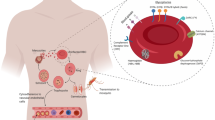Abstract
The symposium on “G6PD Deficiency, Diet, and Adaptation to Malaria” was held in Cortona, Italy on July 3,4,5 1995 under the auspices of the Congress of the International Union of Anthropological and Ethnological Sciences (IUAES). The Congress had actually taken place in Florence in April 1995, and the G6PD symposium was a satellite session to that meeting. Professor Brunetto Chiarelli, of the Istituto di Antropologia at the University of Florence, was the program chairman for the Congress.
The general theme of the Congress was “Biodemography and Human Evolution,” and the G6PD symposium was consistent with this topic. In its broadest sense the symposium focused on biocultural factors which have influenced evolution at the G6PD locus and the pattern of population variation that has consequently emerged in this genetic system. A more specific sub-theme, reflected in the title of the symposium, was the interaction between dietary factors and the G6PD locus in providing antimalarial protection to human populations.
Similar content being viewed by others
References
Arese, P. & De Flora, A. 1990.Pathophysiology of hemolysis in glucose-6-phosphate dehydrogenase deficiency. Seminars in Hematology, 27, 1–40.
Chevion, M., 1991.Protection against free radical-induced and transition metal mediated damage: the use of “push” and “pull” mechanisms. Free Radical Research Communications, 12–13, 691–696.
Gloria-Bottini, F., Falsi, A. M., Mortera, J. & Bottini, E., 1980.The relations between G-6-PD deficiency, thalassemia and malaria further analysis of data from Sardinia and the Po valley. Experientia, 36, 541–542.
Golenser, J., Marva, E., Har-El, R., et al., 1991.Induction of oxidant stress by iron available in advanced forms of Plasmodium falciparum. Free Radical Research Communications, 12–13, 639–643.
Har-El, R., Marva, E., Chevion, M. & Golenser, J., 1993.Is hemin responsible for the susceptibility of plasmodia to oxidant stress? Free Radical Research Communications, 18, 279–290.
Lisa, A., Astolfi, P., Degioanni, A., Pasquale, C., & Zei, G., 1994.Differential fertility as a mechanism maintaining balanced polymorphism in Sardinia. Human Biology, 66, 683–698.
Marquardt, R. R., & Arbid, M. S. S., 1988.Protection against the toxic effects of the favism factor (divicine) in rats by vitamins E, A, and C and iron Chelating agents. J. Sci. Food Agric., 43, 155–166.
Meloni, T., Cutillo, S., Testa, U. & Luzzatto, L., 1987.Neonatal jaundice and severity of glucose-6-phosphate dehydrogenase deficiency in Sardinian babies. Early Human Development, 15, 317–322.
Ninfali, P., Baronciani, L., Ruzzo, A. M., Fortini, C., et al. 1993.Molecular analysis of G6PD variants in northern Italy: a study of the population from the Ferrara district. Human Genetics, 92, 139.
Author information
Authors and Affiliations
Rights and permissions
About this article
Cite this article
Greene, L.S., Danubio, M.E. G6PD deficiency, diet, and adaptation to malaria. Hum. Evol. 12, 209–219 (1997). https://doi.org/10.1007/BF02438070
Issue Date:
DOI: https://doi.org/10.1007/BF02438070




